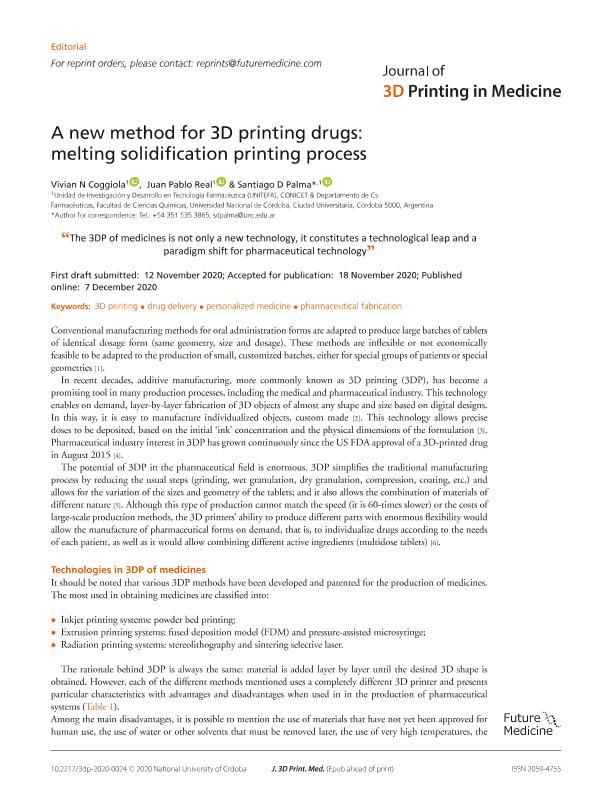Artículo
A new method for 3D printing drugs: Melting solidification printing process
Fecha de publicación:
09/2020
Editorial:
Future Medicine
Revista:
Journal of 3D Printing in Medicine
ISSN:
2059-4755
e-ISSN:
2059-4763
Idioma:
Inglés
Tipo de recurso:
Artículo publicado
Clasificación temática:
Resumen
Conventional manufacturing methods for oral administration forms are adapted to produce large batches of tablets of identical dosage form (same geometry, size and dosage). These methods are inflexible or not economically feasible to be adapted to the production of small, customized batches, either for special groups of patients or special geometries . In recent decades, additive manufacturing, more commonly known as 3D printing (3DP), has become a promising tool in many production processes, including the medical and pharmaceutical industry. This technology enables on demand, layer-by-layer fabrication of 3D objects of almost any shape and size based on digital designs. In this way, it is easy to manufacture individualized objects, custom made . This technology allows precise doses to be deposited, based on the initial ?ink? concentration and the physical dimensions of the formulation . Pharmaceutical industry interest in 3DP has grown continuously since the US FDA approval of a 3D-printed drug in August 2015. The potential of 3DP in the pharmaceutical field is enormous. 3DP simplifies the traditional manufacturing process by reducing the usual steps (grinding, wet granulation, dry granulation, compression, coating, etc.) and allows for the variation of the sizes and geometry of the tablets; and it also allows the combination of materials of different nature . Although this type of production cannot match the speed (it is 60-times slower) or the costs of large-scale production methods, the 3D printers? ability to produce different parts with enormous flexibility would allow the manufacture of pharmaceutical forms on demand, that is, to individualize drugs according to the needs of each patient, as well as it would allow combining different active ingredients (multidose tablets)
Archivos asociados
Licencia
Identificadores
Colecciones
Articulos(UNITEFA)
Articulos de UNIDAD DE INVESTIGACION Y DESARROLLO EN TECNOLOGIA FARMACEUTICA
Articulos de UNIDAD DE INVESTIGACION Y DESARROLLO EN TECNOLOGIA FARMACEUTICA
Citación
Coggiola, Vivian Natali; Real, Juan Pablo; Palma, Santiago Daniel; A new method for 3D printing drugs: Melting solidification printing process; Future Medicine; Journal of 3D Printing in Medicine; 4; 3; 9-2020; 131-134
Compartir
Altmétricas




